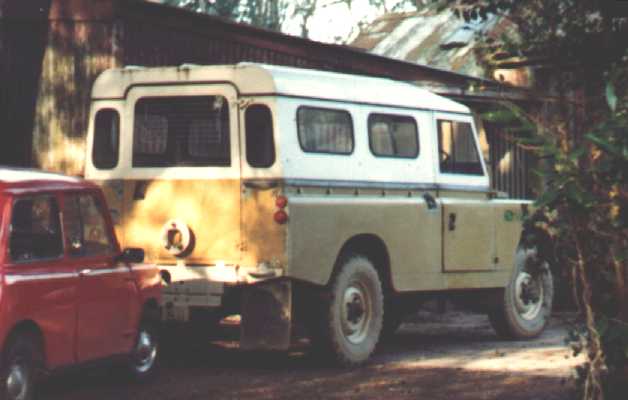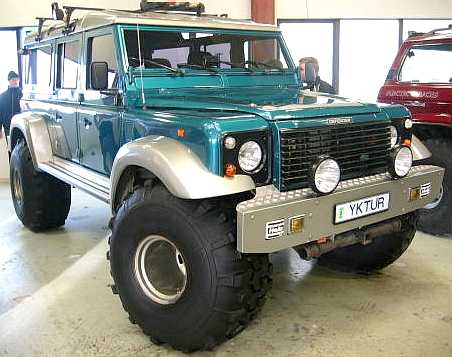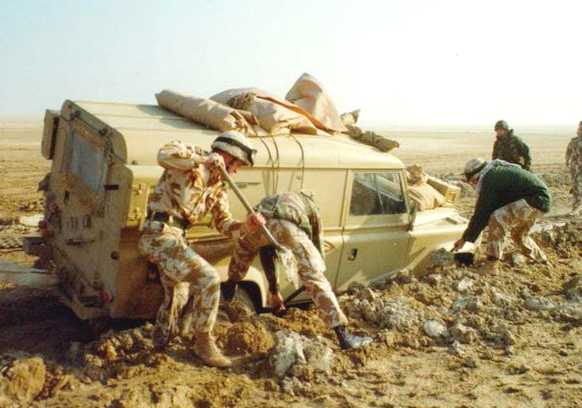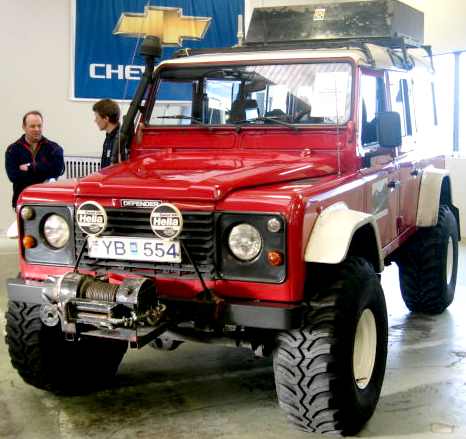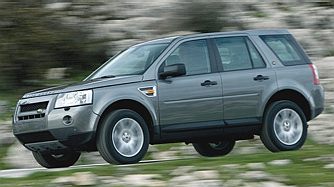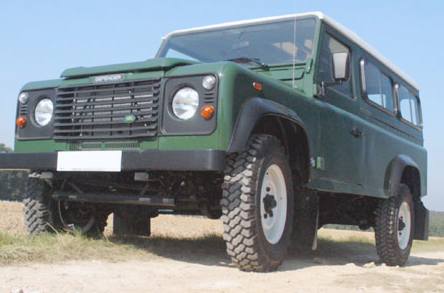|
LAND ROVER WORKING VEHICLES
|
|||||||||||||||||||||||
|
AUTOMOTIVE A TO Z CLIMATE CHANGE EVENTS FUEL CELLS HOME HYDROGEN UTILITIES |
|||||||||||||||||||||||
|
Land Rover is a British all terrain vehicle and sport utility vehicle (SUV) manufacturer, based in Solihull, England. Originally the term Land Rover referred to one specific vehicle, a pioneering civilian all-terrain utility vehicle launched on April 30, 1948 at the Amsterdam Motor Show, but was later used as a brand for several distinct models, all four-wheel drive. Starting out as an internal division of Rover, Land Rover has designed and manufactured a range of four-wheel drive vehicles under a succession of owners, including British Leyland, British Aerospace and BMW. Today, the marque is part of the Premier Automotive Group, a division of the Ford Motor Company, and one of the best internationally known and longest lived nameplates of rugged SUVs together with the U.S. Jeep.
Land Rover long wheelbase safari wagon, 1982. In 2021, Sir Jim Ratcliffe is looking to breathe life back into the defunct marque with his Ineos Grenadier.
The Land Rover above was a local engineer's first four wheel drive vehicle. Bought from a dealer at Selmeston, East Sussex for £900 after it had returned from safari while shooting a TV documentary film.
The long wheelbase truck had a 2.4 litre petrol engine. Even with freewheel hubs it was a thirsty beast and once got stuck in Robins Post Lane, Hailsham, while off-roading on waterlogged clay paths - eventually freed by rocking and going faster. Great fun to own and a reliable workhorse with a starting handle for those occasions when the battery lets you down - and it did. But watch those shoulder muscles, it takes a hefty swing to start.
The resale value of these classics is so good the then owner made a profit, selling it for £1,100 after some years use. The truck is believed to be in regular use today. The then current designs were not enticing enough to keep the brand's sales high volume. What Land Rover (any brand) needs is a design to make the buyer's mouth water. They certainly have the reputation, but at the moment they need to keep an eye on the competition, if they don't want to got the way of BSA, Triumph and Norton. "I'd like to give them a boost."
Land Rovers are manufactured primarily at the Solihull plant, near the major manufacturing centre of Birmingham, England. Production of the "Freelander" has moved recently to the Jaguar car factory at Halewood near Liverpool. Another site at Gaydon in Warwickshire is home to the Land Rover research and design headquarters.
Land Rovers have competed in the Paris Dakar Rally as well as being the vehicle used for the Camel Trophy as part of a sponsorship deal. Now, Land Rover has its own G4 challenge. History
The first Land Rover was designed in 1947 in the United Kingdom by Maurice Wilks, chief designer at the British car company Rover on his farm in Newborough, Anglesey. It is said that he was inspired by an American World War II Jeep that he used one summer at his holiday home in Wales. The first Land Rover prototype 'centre steer' was built on a Jeep chassis. A distinctive feature is their bodies, constructed of a lightweight rustproof proprietary alloy of aluminium and magnesium called Birmabright. This material was used owing to post war steel shortages and a plentiful supply of post-war aircraft aluminium. This metal's resistance to corrosion was one of the factors that allowed the vehicle to build up a reputation for longevity in the toughest conditions. The early choice of colour was dictated by military surplus supplies of aircraft cockpit paint, so early vehicles only came in a shade of light green; all models until recently feature sturdy box section ladder-frame chassis.
The early vehicles, such as the Series 1, were designed to be field-serviced; advertisements for Rovers cite vehicles driven thousands of miles on banana oil. Now with more complex service requirements this is less of an option. The British Army maintains the use of the mechanically simple 2.5 litre 4 cylinder 300TDi engined versions rather than the electronically controlled 2.5 litre 5 cylinder TD5 to retain some servicing simplicity. This engine also continued in use in some export markets using units built at a Ford plant in Brazil, where Land Rovers were built under license and the engine was also used in Ford pick-up trucks built locally. Production of the Tdi engine ended here in 2006, meaning that Land Rover no longer offer it as an option. International Motors of Brazil offer an engine called the 2.8 TGV Power Torque, which is essentially a 2.8-litre version of the 300Tdi, with a corresponding increase in power and torque.
A nice LWB safari wagon
Challenge of Japanese makes
Since the 1970s, in most remote areas of Africa, South America, Asia and in the Australian Outback the somewhat similar Toyota Land Cruiser has overtaken the Land Rover as the utility 4x4 of choice, partly because of the better support network and reputation for reliability of Japanese competitors. In Australia at least, pricing is actually comparable or in favour of the Land Rover. Another reason seems to be the 'leadfoot' factor - the workhorse Toyota models tend to have larger engines than the comparable Land Rover models.
In Britain, the Land Rover fell from favour with the farming community with the arrival of less expensive Japanese alternatives, with Daihatsu Fourtracks and Isuzu Troopers becoming a common sight on farms around the country, until rust eventually ended their working lives. However, with subtle improvements to the Defender in the early 1990s, and with the introduction of better, more reliable engines in the form of the TDi (especially the 300TDi) and the five-cylinder TD5, many farms once again have a Land Rover Defender in their yard.
Company timeline
Media
Land Rovers, particularly the commercial and military models, became ubiquitous throughout rural areas and in the developing World. The Land Rover featured in the South African movie The Gods Must Be Crazy illustrates the love-hate relationship many owners feel with the earlier Series 1, 2 and 3 vehicles. In the US, the 1960s TV series Daktari featured a Land Rover that was the subject of Corgi models that still frequent eBay listings. In the movie Ace Ventura many Land Rovers are used.
Land Rover Wolf of the 1st Armoured Division being extracted during the Gulf War
Military use
Since the very beginning all Series and Defender models have been used in a military capacity. Often this has entailed just slightly modifiying civilian models, but some dedicated military models have also been developed. The Discovery has also been used in small numbers, mostly as liaison vehicles. Two models that have been designed for military use from the ground up are the 101 Forward Control from the early 1970s and the Lightweight or Airportable from the late 1960s. The latter was intended to be transported by helicopter.
Military modifications includes 24 Volt electrics, convoy lights, electronic suppression of the ignition system, blackout curtains and mounts for special equipment and small arms.
Military uses includes light utility vehicle, communcations platform, weapon platform for recoilless rifles, TOWs or machine guns, ambulances and workshops.
One famous adaptation of Land Rovers to military purposes is the "Pink Panther" models. Approximately 100 Series IIAs were adapted to reconnaissance use by the British special operations forces SAS. For desert use they were often painted pink, hence the name. The vehicles were fitted with among other gear a sun compass, machine guns, larger fuel tanks and smoke dischargers. Similar adaptations were later made to Series IIIs and 90/110/Defenders.
Series and Defenders have also been uparmoured. The most widespread of these is the Shorts Shorland, built by Shorts Brothers of Belfast. The first of these were delivered in 1965 to the Royal Ulster Constabulary, the Northern Ireland police force. They were originally 109" models with an armoured body and a turret from the Ferret armoured car. Later they were upgraded a parallel with Land Rover's upgrades to the base vehicles, and they are still marketed. In 1990 there had been more than 1.000 produced.
The most radical conversion of a Land Rover for military purposes was the Centaur halftrack. It was based on a Series III with a V8 engine and a shortened belt drive from the Alvis Scorpion light tank. A small number was manufactured, and they were used by among others Ghana.
The Land Rover Wolf is also used by military forces throughout the world. In the UK armed forces, the more expensive Pinzgauer, now built in the UK, is increasingly common in roles previously the preserve of the Land Rover Defender such as ambulances, artillery tractor and weapons platform with 188 Pinzgauers in service and 15,000 Land Rovers.
Nice custom SWB Defender
Luxury
The Range Rover has helped to define the Land Rover brand as much as the traditional Series and later Defender vehicles. Its upmarket image is peerless in the SUV market and led to a proliferation of products with the introduction of the Discovery/LR3, Freelander and Range Rover Sport.
By the late 1990's Land Rover were concerned that the brand was fragmented in the eyes of customers who saw a collection of products, which had little relation to each other. In order to exert more leverage from marketing-spend, a re-think led to a departure from the traditional 'mud and guts' advertising to more aspirational and luxury orientated marketing to better reflect the true customer-base.
This product strategy has kept Land Rover in business. In 2005 it was the most profitable part of Ford's Premier Automotive Group (PAG) brand portfolio. In cities like Seattle, large Land Rover dealers now occupy sites that once sold Ford, Mercury, or Nissan lines. Land Rovers profits should continue to rise with the introduction of the new Freelander at the end of 2006 and the new Defender in the summer of 2007.
Land Rover Freelander/LR2 - tame
Models
There have also been models developed for the Ministry of Defence (United Kingdom) (MoD)
At the 2004 North American International Auto Show, Land Rover introduced its first concept, the Range Stormer (Gritzinger, 2004). A "green" concept known as Land e was recently shown.
The armoured police vehicle, the Shorland, was not a Land Rover produced model but was built from Land Rover parts by Shorts of Belfast. These were used by the Royal Ulster Constabulary and Ulster Defence Regiment until the 1970s, when a more conventional armoured Land Rover Tangi was built.
Current models
Abilities
The use of Land Rovers by the UK and Commonwealth military as well as on long term civilian projects and expeditions is mainly due to the superior off-road performance of the marque. For example, the short wheelbase version of the Land Rover Defender is capable of tackling a gradient of 45 degrees, an approach angle of up to 50 degrees, a departure angle of 53 degrees and a ramp break-over of up to 155 degrees - greatly superior not just to urban 4x4s but to military vehicles such as the HMMWV and Pinzgauer High Mobility All-Terrain Vehicle. A distinctive feature of all Land Rover products has been their exceptional axle articulation (the degree to which the wheels have vertical travel, with high amounts allowing them to maintain contact (and traction) with the ground over uneven surfaces), which is currently 7 inches (178mm) at the front axle and 8.25 inches (210mm) at the rear on basic Defender models.
Right from the start in 1948, PTOs (Power Take Offs) were integral to the Land Rover concept, enabling farm machinery and many other items to be run with the vehicle stationary. Maurice Wilks was very clear about this, and his original instruction was "...to have power take-offs everywhere!" The 1949 report by the UK National Institute of Agricultural Engineering and Scottish Machinery Testing Station described it thus:
"The power take-off is driven through a Hardy-Spicer propeller shaft from the main gearbox output and two interchangeable pinions giving two ratios. The pto gearbox casing is bolted to the rear chassis cross-member and an 8 in x 8 in belt pulley driven from the pto shaft through two bevel gears can be bolted to the pto gearbox casing."
Safety
Road accident statistics on a model-by-model basis from the UK Department of Transport show that the Land Rover Defender and Land Rover Discovery are the safest cars on the UK roads (measured in terms of chance of death in an accident) - between three times safer than the safest Volvo models, twice as safe (half the death-rate per accident) compared with the Jeep Cherokee and Toyota Land Cruiser and only matched by the Mercedes-Benz S-Class and Jaguar XJ.
Quality problems
Recently the Land Rover marque has built a negative reputation for reliability and build quality, and this is reflected in its showing in various industry quality and dependability related surveys, as detailed below.
Beginning with the Discovery Series III (LR3 in the US) model, one of the replacement power plants for the new model will be a 4.2 L V8 engine developed by Jaguar (Jaguar is also part of the Ford Group).
Some of the service problems in US specification Land Rover Defender and Discovery models are related to the Rover V8 petrol engine, as Land Rover increased the displacement and otherwise modernized the engine, which was designed in the late 1950s by General Motors for Buick. The same engine has powered a variety of other British cars, including the Rover 3500 and Triumph TR8.
Most European, South African and Australian specification Defenders and Discovery models are now equipped with the TD5 diesel engine and reliability has still proven a problem as detailed in the surveys above. Part of the problem is also caused by the manufacturing methods used. The Defender is still largely hand-built, with aluminum body panels mounted on a steel chassis. This makes it very hard for the vehicle to have the same rigidity and inter-panel sealing as is found on modern vehicle. The 1980s saw numerous cut-backs to the utility Land Rover line (at that time, the Ninety/One Ten range), which included the replacement of the galvanised metal body cappings (as used since 1948) with simple painted items. This led to rapid corrosion of these parts. Similar economy measures were put in place. Recently increased investment under Ford has seen the return of the galvanised cappings, and design changes to reduce corrosion (such as the introduction of a one-piece rear door on Station Wagon and Hard Top models, which previously had doors made from panels over a steel frame).
Land Rover still makes heavy use of the British Leyland parts bin on its older models (the Defender and Freelander in particular), and this as well as its parts-sharing scheme is often cited as the cause of many malfunctions. It now appears that Ford is attempting to legitimately address the Land Rover quality issues. It was reported in the Birmingham Post on 27th May 2004 that Ford's senior management have given the Land Rover plant 8 weeks to come up with a "road map" to address the quality issues at Land Rover and bring its competitiveness up to global standards in 5 years. Ford has threatened Solihull with closure unless significant improvements are realised, and with no replacement for the Jaguar X-type on the cards, it seems likely that there will be sufficient extra capacity at Halewood in the coming years to accommodate the entire Land Rover range. Land Rover's CEO described this as "crunch time" for Land Rover.
Despite the recent drops in quality, it is rumored that 75% of all Land Rovers produced since 1955 are still on the road. This figure may be misleading, due to the wider range of vehicles and much higher production of recent years. Although the simplicity of build & cross compatibility of parts with many of the earlier models together with the enthusiasm of many owners has ensured many vehicles have stayed on the road, the longevity of individual vehicles may also tend to hide any improvements in production quality as assembly faults, once fixed, may stay fixed, and so may only matter to the first buyer. Enthusiasts of the marque and commercial users often point out that the mechanical components of the vehicles are very tough and reliable, whereas other manufacturers not only produce models with assembly faults which are recalled, but do not tend to remain as reliable as Land Rover products in the long run. It is also true that much larger proportion of early Land Rover Discovery, the first vehicle to be produced in very high numbers, remain in everyday use than can be said of rival manufacturers.
Land Rover Defender 110
Bicycle range
In June 2004 Landrover released a comprehensive 25 model range of bicycles to complement the automotive range. The three main ranges are the 'Defender' the 'Discovery' and the 'Freelander'. Each range has its differernt attributes. The 'Discovery' is an all-rounder bicycle and it is suited to a mix of different terrains. The 'Defender' range is most suited to rugged terrain and off road pursuits whereas the 'Freelander' Is designed for an urban lifestyle. All bikes are made from lightweight Aluminium and range from £200-£400. LINKS and REFERENCE
Land Rover - Youtube
Any form of electric vehicle is better than petrol or diesel, but an electric vehicle that can refuel in a few minutes will obviously have much more customer appeal than an EV that has to wait 30 minutes or even hours to charge up.
Battery technology is improving daily. A car with the new generation of battery cartridge exchange built in and the ability to load its own cartridge, will encourage energy companies to build service forecourts.
Please click on the links above to find out about these famous automotive makers. If your company is not included and you would like to be listed, please let us know.
UK VEHICLE INSURANCE ONLINE A - Z
No matter what car, van or bike you drive, we're all looking for great value and quality in our UK motor insurance? But who is the best - who is the cheapest and who offers the great service in the event of a claim?
See the insurance companies below who claim to offer competitive cover at sensible prices, our guide to the jargon and tips for cutting your quote - Good Luck:-
SMART-CHARGER
- Potentially the world's fastest electric car
PLEASE USE OUR A TO Z SITE INDEX TO NAVIGATE THIS SITE HOME
|
|||||||||||||||||||||||
|
The
content of this website is copyright © 1991 and 2013 Electrick
Publications. All rights reserved. The bluebird logo |
|||||||||||||||||||||||
